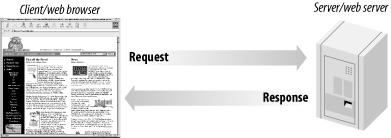HTTP allows resources to be communicated and shared over the Web. From a network perspective, HTTP is an applications-layer protocol that is built on top of the TCP/IP networking protocol suite. Most web servers and web browsers communicate using the current version, HTTP/1.1. Some browsers and servers use the previous version, HTTP/1.0, but most HTTP/1.1 software is backward-compatible with HTTP/1.0.
HTTP communications dominate Internet network traffic. In 1997, HTTP accounted for about 75% of all traffic.[1] We speculate that this percentage is now even higher due to the growth in the number and popularity of HTTP-based applications such as free email services.
[1] From K. Thompson, G. J. Miller, and R. Wilder. "Wide-area internet traffic patterns and characteristics," IEEE Network, 11(6):10-23, November/December 1997.
HTTP example
HTTP is conceptually simple: a client web browser sends a request for a resource to a web server, and the web server sends back a response. The HTTP response carries the resource-the HTML document, image, or output of a program-back to the web browser as its payload. This simple request-response model is shown in Figure 1-2.
Figure 1-2. A web browser makes a request and the web server responds with the resource

An HTTP request is a textual description of a resource and additional header information. Consider the following example request:
GET /Preface.htmll HTTP/1.0 From: Alexa@computer.org (Alexa Xyz) User-agent: Alexa-fake-browser/version-1.0 Accept: text/plain, text/html
This example uses a GET method to request an HTML page Preface.htmll with HTTP/1.0. In this example, three additional header lines identify the user and the web browser and define what data types can be accepted by the browser. A request is normally made by a web browser and may include other headers; the previous example was created manually by typing the request into Telnet software.
An HTTP response has a response code and message, additional headers, and usually the resource that has been requested. An example response to the request for Preface.htmll is as follows:
HTTP/1.0 200 OK Date: Sat, 21 Jul 2002 03:44:25 GMT Server: Apache/1.3.20 Content-type: text/html Content-length: 88 Last-modified: Fri, 1 Feb 2002 03:40:03 GMT <html><head> <title>Test Page</title></head> <body> <h1>It Worked!</h1> </body></html>
The first line of the response agrees to use HTTP/1.0 and confirms that the request succeeded by reporting the response code 200 and the message OK; another common response is 404 Not Found. In this example, five lines of additional headers identify the current date and time, the web server software, the data type, the length of the response, and when the resource was last modified. After a blank line, the resource itself follows. In this example the resource is the requested HTML document, Preface.htmll.
State
Traditional database applications are stateful. In traditional database applications, users log in, run related transactions, and then log out when they are finished. For example, in a bank application, a bank teller might log in, use the application through a series of menus as he serves customer requests, and log out when he's finished for the day. The bank application has state: once the teller is logged in, he can interact with the application in a structured way using menus. When the teller has logged out, he can no longer use the application.
HTTP is stateless. Statelessness means that any interaction between a web browser and a web server is independent of any other interaction. Each HTTP request from a web browser includes the same header information, such as the security credentials of the user, the types of pages the browser can accept, and instructions on how to format the response. Statelessness has benefits: the most significant are the resource savings from not having to maintain information at the web server to track a user, and the flexibility to allow users to move between unrelated pages or resources.
Because HTTP is stateless, it is difficult to develop stateful web database applications. What is needed is a method to maintain state in HTTP so that information flows and structure can be imposed. A common solution is to exchange a token between a web browser and a web server that uniquely identifies the user and her session. Each time a browser requests a resource, it presents the token, and each time the web server responds, it returns the token to the web browser. The token is used by the middle-tier software to restore information about a user from her previous request, such as which menu in the application she last accessed. Exchanging tokens allows stateful structure such as menus, steps, and workflow processes to be added to the application.